
English
Stereo headphones
Features
400 kJ/m
3
high power neodymium magnets produce
high-resolution treble and midrange with powerful bass
Hybrid silicone rubber earbuds (S, M, L) supplied for
secure fitting and long-term wearing comfort
Y-type cord with cord slider to prevent cord tangling
How to use
Wearing the headphones (see fig. )
Wear the earpiece marked in your right ear and the one
marked
in your left ear.
There is a tactile dot on the unit marked
to distinguish
the left side.
How to use the cord slider (see fig. )
Move up and down to change the split position of the cord.
After you use the headphones, keep them with the cord
slider high positioned to avoid entangling the cord.
How to install the earbuds correctly
(see fig. )
If the earbuds do not fit your ears correctly, low-bass sound
may not be heard. To enjoy better sound quality, change the
earbuds to another size, or adjust the earbuds position to sit
on your ears comfortably and fit your ears snugly.
If the earbuds do not fit your ears, try another size. Confirm
the size of the earbuds by checking color inside
(s
ee fig. -).
When you change the earbuds, turn to install them firmly
on the headphones to prevent the earbud from detaching
and remaining in your ear.
Earbud sizes (inside color)
Small
Large
SS*
(Red)
S
(Orange)
M
(Green)
L
(Light blue)
* This size is optional and available at purchase.
To detach an earbud (see fig. -)
While holding the headphone, twist and pull the earbud off.
Tip
If the earbud slips and cannot be detached, wrap it in a dry soft cloth.
To attach an earbud (see fig. -)
Push the parts inside of the earbud into the headphone until
the projecting part of the headphone is fully covered.
Cleaning the earbuds
Remove the earbuds from the headphones, and wash them
with a mild detergent solution.
Specifications
Type: Closed, dynamic
Driver unit: 9 mm (CCAW adopted),
dome type
Power handling capacity: 100 mW (IEC*)
Impedance: 16 Ω at 1 kHz
Sensitivity: 100 dB/mW
Frequency response: 8 – 22,000 Hz
Cord: 1.2 m (47
1
/4 in), Litz cord
Y-type
Plug:
Gold-plated L-shaped
stereo mini plug
Mass: Approx. 3 g (0.11 oz)
without cord
Supplied accessories
Earbuds (S × 2, M × 2, L × 2), Operating Instructions (1)
* IEC = International Electrotechnical Commission
Design and specifications are subject to change without
notice.
Precautions
Please keep your headphones clean at all times especially
inside the rubber earbud (see fig. ).
If any dust or ear wax inside the earbud, you may
experience some listening difficulties.
Listening with headphones at high volume may affect
your hearing. For traffic safety, do not use while driving
or cycling.
The earbuds may deteriorate due to long-term storage or
use.
Install the earbuds firmly onto the headphones. If an
earbud accidentally detaches and is left in your ear, it may
cause injury.
Note on static electricity
In particularly dry air conditions, mild tingling may be felt
on your ears. This is a result of static electricity accumulated
in the body, and not a malfunction of the headphones.
The effect can be minimized by wearing clothes made from
natural materials.
Optional replacement earbuds can be ordered from your
nearest Sony dealer.
Français
Casque d’écoute stéréo
Caractéristiques
Aimants au néodyme haute puissance (400 kJ/m
3
)
produisant des aigus et fréquences moyennes à haute
résolution, avec des graves puissants
Oreillettes en caoutchouc de silicone hybride (S, M, L)
pour assurer le confort à long terme et un maintien solide
Cordon de type Y avec glissière pour prévenir les
entortillements
Procédure d’utilisation
Port du casque d’écoute (voir fig. )
Portez l’écouteur marqué dans l’oreille droite et l’écouteur
marqué
dans l’oreille gauche.
L’écouteur gauche, marqué ,
porte un point tactile
permettant de l’identifier.
Comment utiliser la glissière du cordon
(voir fig. )
Déplacez-la vers le haut ou vers le bas pour modifier la
position de division du cordon.
Avant de ranger les écouteurs, remontez la glissière de
serrage afin d’éviter que le cordon ne s’emmêle.
Installation correcte des oreillettes
(voir fig. )
Si les oreillettes ne s’adaptent pas bien à vos oreilles, vous
n’entendrez peut-être pas les sons très graves. Pour profiter
d’un son de meilleure qualité, changez la taille des oreillettes
ou ajustez-les afin qu’elles s’adaptent bien à la forme de vos
oreilles et qu’elles soient confortablement installées.
Si les oreillettes ne tiennent pas dans les oreilles, essayez une
autre taille. Vérifiez la taille des oreillettes en contrôlant la
couleur à l’intérieur de celles-ci (voir fig.
-).
L
orsque vous changez les oreillettes, tournez-les pour les
installer fermement sur les écouteurs afin d’éviter qu’elles se
détachent et restent accrochées dans les oreilles.
Taille des oreillettes (couleur intérieure)
Petit
Grand
SS*
(Rouge)
S
(Orange)
M
(Vert)
L
(Bleu clair)
* Cette taille est vendue en option.
Pour détacher l’oreillette (voir fig. -)
Tout en tenant l’écouteur, tournez l’oreillette et détachez-la.
Conseil
Si l’oreillette glisse et ne se détache pas, entourez-la d’un linge doux et
sec.
Pour fixer l’oreillette (voir fig. -)
Enfoncez l’intérieur de l’oreillette dans l’écouteur jusqu’à ce
que la partie saillante de celui-ci soit complètement
recouverte.
Nettoyage des oreillettes
Retirez les oreillettes des écouteurs et lavez-les à la main à
l’aide d’une solution détergente douce.
Spécifications
Type : Fermé, dynamique
Transducteur : 9 mm, type à dôme
(CCAW)
P
uissance admissible : 100 mW (CEI*)
Impédance : 16 Ω à 1 kHz
Sensibilité : 100 dB/mW
Réponse en fréquence : 8 – 22 000 Hz
Cordon : 1,2 m (47
1
/4 po), Cordon
litz en Y
Fiche : Mini-fiche stéréo en L
plaquée or
Poids : Environ 3 g (0,11 oz) sans
cordon
Accessoires fournis
Oreillettes (S × 2, M × 2, L × 2), Mode d’emploi (1)
* CEI = Commission Electrotechnique Internationale
La conception et les spécifications sont sujettes à
modification sans préavis.
Précautions
Veillez toujours à maintenir la propreté de votre casque
d’écoute, notamment au niveau de la partie en caoutchouc
de l’oreillette (voir fig. ).
S
i de la poussière ou du cérumen pénètre dans l’oreillette,
vous risquez de rencontrer des difficultés d’écoute.
Vous risquez de subir des lésions auditives si vous utilisez
ces écouteurs à un volume trop élevé. Pour des raisons de
sécurité, n’utilisez pas ce casque d’écoute en voiture ou à
vélo.
Les oreillettes peuvent s’abîmer après une utilisation
intensive ou si elles restent rangées pendant longtemps.
Fixez correctement les oreillettes sur les écouteurs. Si une
oreillette se détachait accidentellement et restait coincée
dans votre oreille, elle risquerait de vous blesser.
Remarque à propos de l’électricité statique
Si l’air est particulièrement sec, vous pouvez ressentir de
légers fourmillements dans les oreilles. Cela s’explique par
l’accumulation d’électricité statique dans le corps et il ne
s’agit pas d’un dysfonctionnement des écouteurs.
Vous pouvez atténuer cet effet en portant des vêtements en
matière naturelle.
Des oreillettes de rechange en option peuvent être
commandées auprès de votre détaillant Sony le plus
proche.
Cord slider
Glissière du cordon
Tactile dot
Point tactile
Colored parts
Parties colorées
Sectional View
Vue en coupe
Stereo
Headphones
MDR-PQ6
©2010 Sony Corporation Printed in Thailand
Operating Instructions
Mode d’emploi
Manual de instrucciones
4-272-561-12(1)

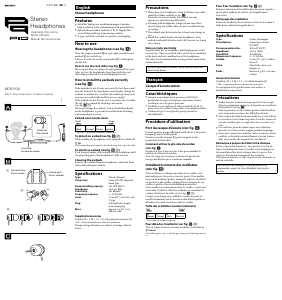


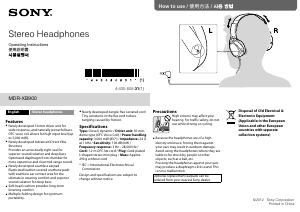
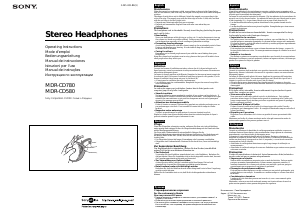
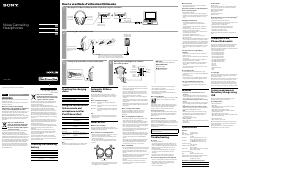
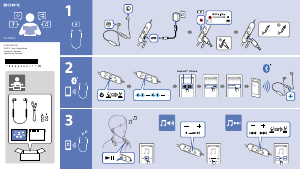
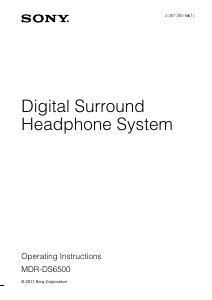
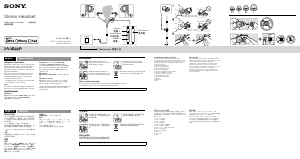
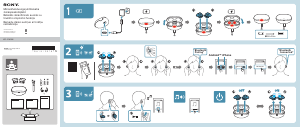
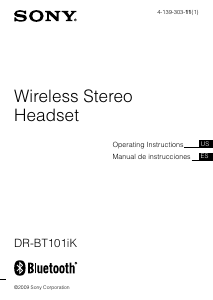
Join the conversation about this product
Here you can share what you think about the Sony MDR-PQ6 Headphone. If you have a question, first carefully read the manual. Requesting a manual can be done by using our contact form.